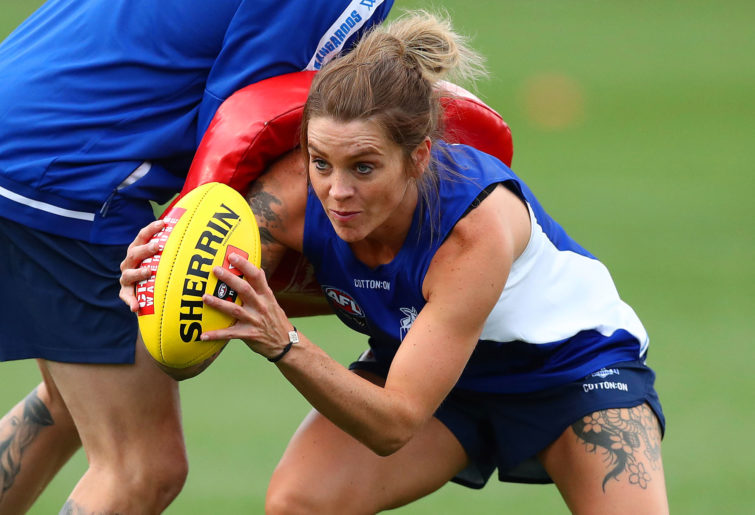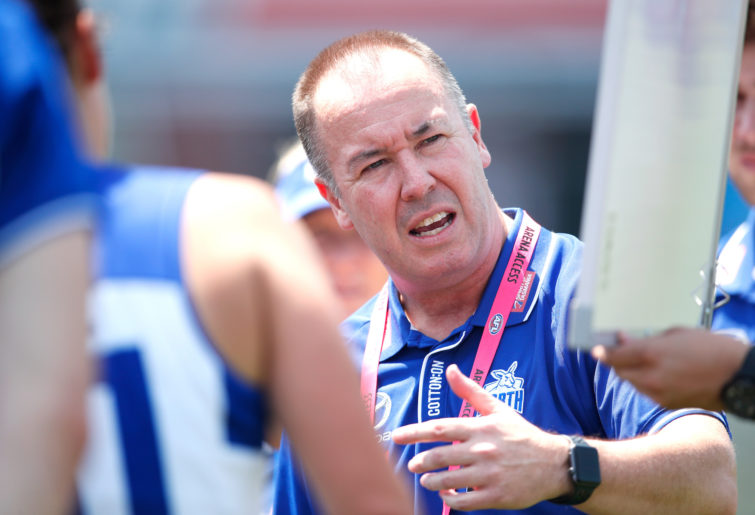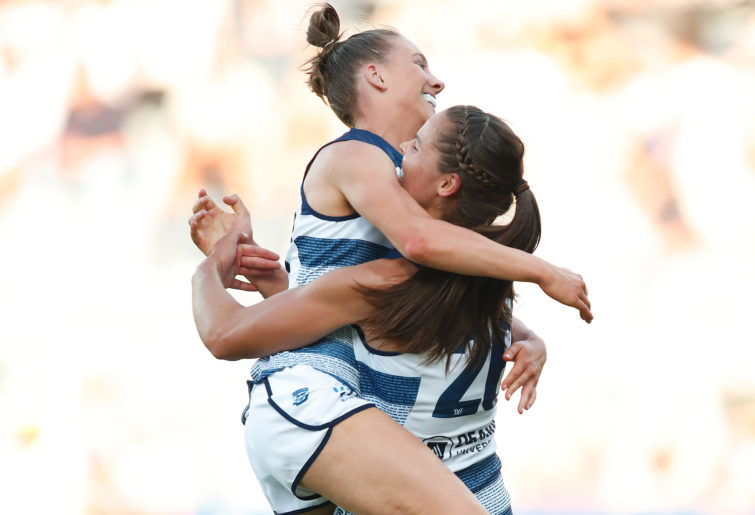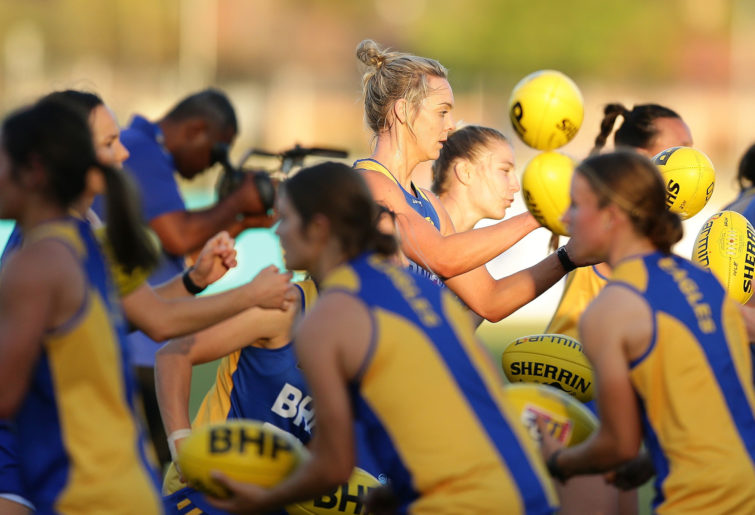AFL News: Scott hits out at 'offensive' Tribunal call to clear Cameron, Pies to swoop on star Dog?
Geelong coach Chris Scott has hit out at the AFL Tribunal's decision to clear Charlie Cameron for his dangerous tackle on Jake Lever, saying…
Opinion
The Roos are cooked.
Things move fast in the AFLW. For a while I’ve been questioning whether a strategy of recruiting primarily mature-aged players would work in a competition where the emerging young talent is disproportionately better than the older players.
My conclusion was that it would work for a while, because the kids will take a while to develop, but that North’s premiership window would be very small. In fact, that window may have been in 2020, when North looked the equal best team in the comp along with Fremantle, but now COVID has destroyed those dreams, and North have missed their chance.
It’s not that they’ve suddenly become a bad team. They’ve got some great players, particularly in the midfield, but two losses in a row against Melbourne and now Collingwood are revealing.
In both games they’ve been competitive in contested possessions and tackles, proving what a tough, hard, inside unit they are. But against Melbourne they lost uncontested possessions 110 to 75, and against Collingwood by a whopping 174 to 101.
The one hallmark of the younger players entering the AFLW is that they’re both faster and more skilful, on average, than the veterans. Against North, both Melbourne and Collingwood backed their faster hands and feet to control the play and not let North Melbourne get as much of the ball.

(Photo by Kelly Defina/Getty Images)
The only team that can get away with not controlling the play with lots of possession is Fremantle, but Fremantle are the fastest team in the league and play brutally direct, while North are not and do not.
Both Melbourne and Collingwood poured enormous defensive pressure onto North, scrambling their previously elite ball movement and not allowing them clean entries inside 50, resulting in them getting beaten in inside 50 efficiency 70 per cent to 50 against Melbourne, and 44 per cent to 26 against Collingwood.
North’s previous success was built upon a cohesive team of well-drilled, experienced players with an excellent coach, Scott Gowans. They also reigned during a period when many opposition teams were going through transitions, rebuilding their lists, and trying to build that cohesive game plan that served North so well.
Carlton, Collingwood, the Bulldogs, plus of course the expansion teams in 2020 were all still in rebuilding phases, with lists filled with young players not yet sure of their role and not accustomed to playing with new teammates under new coaches.
I’m not sure that Gowans’ departure has hurt North all that much. In the third quarter against Melbourne they looked like their old formidable selves, and in all likelihood they’re a better team than they were last year.

(Photo by Adam Trafford/AFL Media/Getty Images)
But many of those other teams that used to be struggling are no longer struggling, and herein lies the unique dynamic of the AFLW compared to any other competition.
On average I’d guess that each team is currently improving by about 20 per cent per year. Being an older team made up of players with less collective upside, North may have improved by 15 per cent over last year’s very high standard. But Collingwood and the Western Bulldogs, to name just two, have improved by closer to 30 per cent, being stacked with young players with a lot more upside, and having gained experience and cohesiveness in playing together.
Melbourne probably didn’t improve by as much, but they were a top team to begin with, and much of their devastating midfield play against North was controlled by relative youngsters Tyla Hanks and Lilly Mithen, who have both stepped up in a big way this season.
When the Dees’ top draft pick Alyssa Bannan starts delivering in their forward line, Melbourne’s offensive firepower will reach another level. North’s line-up has a few good young players, but nothing like the quality of Bannan, Hanks or others of Melbourne’s young brigade, let alone the Bulldogs’ young brigade to look forward to.
And now, like a 400-metre runner seeing her big lead evaporate in the final stretch, North are watching even expansion teams like Richmond and St Kilda improving at an alarming speed that they, with their older line-up, can’t hope to match.
North will continue to be a strong team this year, and will no doubt crush some of the lesser teams in weeks ahead. Probably they’ll make finals, but given the last two weeks, the chances of them making the grand final look slim, let alone winning it.
They’re still very good, it’s just that everyone else got abruptly better. But that’s what makes the AFLW fun – if teams stop moving for just a moment to enjoy the scenery, they’ll get overtaken and left in the dust of those that kept running.
Geelong need a new coach. We’ve all seen enough at this point, and wondered why this team with lots of good young players are not seeing the kind of improvement that other young teams have seen under different coaches. Yes, they’ve been very unlucky, losing their most talented player Nina Morrison to two successive ACLs, but that can’t explain all of it.
I’m not at all clear on what’s happening with Geelong’s recruitment zone. Apparently it’s ended, so players can no longer select Melbourne zone or Geelong zone prior to draft day.
How prospective young players feel about this, if their lives, jobs or studies are based in Melbourne but they get drafted to play in Geelong, is something Victorian AFL media has left unexplored.

(Photo by Adam Trafford/AFL Media/Getty Images)
Geelong have a long-standing commitment to draft local Geelong players, presumably for exactly this reason – players with lives in Melbourne won’t want to go, so Geelong want players with long-term commitments to the region. So what happens when the Cats get the number one Victorian draft pick at the end of this season, as seems increasingly likely, but that number one pick (almost certainly Georgie Prespakis or Charlie Rowbottom) doesn’t want to go?
Well, there’s a lot of more highly ranked teams who’d be prepared to give an arm and a leg to get either of those two players. North Melbourne, for example, may choose to do a Melbourne-style clean-out of their list at the end of this year, and could offer Geelong some very good players in exchange for that number one pick. And they’d have a lot of competition. In fact, if it happens, it could turn into the biggest bidding war the AFLW has yet seen. Watch this space.
Turning now to West Coast, and as an Eagles fan, I should be depressed by how things stand this season, but I’m not.
Partly, the Eagles’ improvement is real – they’re too small and lacking marking power to play a direct, contested game, so coach Daniel Pratt has them running hard on the outside, playing on at all costs, and burning so much energy in the heat of summer that they’re invariably spent by halftime.
Even so, they were competitive in clearances against GWS despite getting flogged in the hit-outs 39 to 21. They were still in that game at three-quarter time, despite having no forward line to speak of, and actually won clearances against the strong Brisbane midfield 28 to 21 – all without their best player, Dana Hooker, or fast Irish winger Niahm Kelly.

(Will Russell /AFL Photos via Getty Images)
Nineteen-year-old Mikayla Bowen has shown massive improvement in the middle, 18-year-old Isabella Lewis is having an outstanding first year, and Aisling McCarthy has been a gun as well. Next year, with Hooker back and hopefully with a bit more luck with injury, the Eagles could have one of the strongest midfields in the competition – strong enough, in fact, that Hooker, Emma Swanson and McCarthy could possibly rotate through the forward line without losing too much grunt in the middle.
That just leaves the full-time forward line (currently non-existent) and the back line (currently weak but with some young prospects). But the WAFLW is underway once more, showcasing many young talents, and nearly all of the Eagles’ recruits for the next two drafts will be forwards and backs.
One of them will be 16-year-old Ella Roberts, whose most recent game (which she dominated) for Peel Thunder against East Fremantle is available on YouTube. Roberts is 175 centimetres, already running circles around AFLW players in the WAFLW, and is looking comfortably the best young talent to ever come out of Western Australia. She’ll be an Eagle in the 2022 draft, 180-centimetre Amy Franklin will become an Eagle this year, and if some more like them emerge, the Eagles won’t be easy-beats for much longer.